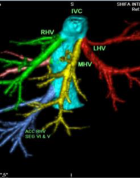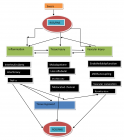Abstract
Review Article
Neurotoxicity related exposure to ambient nanoparticles
Mojtaba Ehsanifar*, Zeinab Montazeri and Mehravar Rafati
Published: 18 January, 2022 | Volume 6 - Issue 1 | Pages: 005-010
Air pollution exposure is among the most prevalent reasons for environmentally-induced oxidative stress and inflammation, both of which are implicated in the central nervous system (CNS) diseases. The CNS has emerged as an important target for adverse health effects of exposure to air pollutants, where it can cause neurological and neurodevelopmental disorders. Air pollution includes various components of gases, particulate matter (PM), ultrafine particulate (UFPs), metals, and organic compounds. An important source of PM and UFPM in the ambient air is associated with air pollution-related trafficking, and primarily diesel exhaust particles (DEPs). Controlled animal studies and epidemiological studies show that exposure to air pollution, and in particular urban air pollution or DEPs, may lead to neurotoxicity. In specific, exposure to air pollutants as an important factor may be in neurodevelopmental disorders (eg Autism) and neurological disorders (eg.., Alzheimer’s Disease (AD)). The most noticeable effects of exposure to air pollutants in animals and humans are oxidative stress and neurodegeneration. Studies in rats exposed to DEPs showed microglial activity, increased lipid peroxidation, and neuronal accumulation in various areas of the brain, especially the olfactory bulb (OB) and the hippocampus (HI). Disorders of adult neurogenesis were also found. In most cases, the effects of DEP are more pronounced in male mice, probably due to lower antioxidant capacity due to less expression of paraoxonase 2.
Read Full Article HTML DOI: 10.29328/journal.jnnd.1001060 Cite this Article Read Full Article PDF
Keywords:
Air pollution exposure; Diesel exhaust particles; Neurotoxicity; Oxidative stress; Neuro-inflammation; CNS diseases; Neurodevelopmental disorders
References
- Costa LG, Cole TB, Coburn J, Chang YC, Dao K, et al. Neurotoxicants are in the air: convergence of human, animal, and in vitro studies on the effects of air pollution on the brain. Biomed Res Int. 2014; 2014. PubMed: https://pubmed.ncbi.nlm.nih.gov/24524086/
- Van Donkelaar A, Martin RV, Brauer M, Boys BL. Use of satellite observations for long-term exposure assessment of global concentrations of fine particulate matter. Environ Health Perspect. 2015; 123: 135-143. PubMed: https://pubmed.ncbi.nlm.nih.gov/25343779/
- Genc S, Zadeoglulari Z, Fuss SH, Genc K. The adverse effects of air pollution on the nervous system. J Toxicol. 2012; 2012:PubMed: https://pubmed.ncbi.nlm.nih.gov/22523490/
- Peters A, Veronesi B, Calderón-Garcidueñas L, Gehr P, Chen LC, et al. Translocation and potential neurological effects of fine and ultrafine particles a critical update. Part Fibre Toxicol. 2006: 3: 13. PubMed: https://pubmed.ncbi.nlm.nih.gov/16961926/
- Ehsanifar M, Tameh AA, Farzadkia M, Kalantari RR, Zavareh MS, et al. Exposure to nanoscale diesel exhaust particles: Oxidative stress, neuroinflammation, anxiety and depression on adult male mice. Ecotoxicol Environ Saf. 2019; 168: 338-347. PubMed: https://pubmed.ncbi.nlm.nih.gov/30391838/
- Jafari AJ, Ehsanifar M, Arfaeinia H. The Share of Different Vehicles in Air Pollutant Emission in Tehran, Using 2013 Traffic Information. Caspian J Health Res. 2016; 2: 28-36.
- Ghio AJ, Smith CB, Madden MC. Diesel exhaust particles and airway inflammation. Curr Opin Pulm Med. 2012; 18: 144-150. PubMed: https://pubmed.ncbi.nlm.nih.gov/22234273/
- Ris C. US EPA health assessment for diesel engine exhaust: a review. Inhal Toxicol. 2007; 19(sup1): 229-239. PubMed: https://pubmed.ncbi.nlm.nih.gov/17886071/
- EPA U. Health assessment document for diesel engine exhaust. Washington, DC, 600/8-90/057F, 2002.
- Pronk A, Coble J, Stewart PA. Occupational exposure to diesel engine exhaust: a literature review. J Expo Sci Environ Epidemiol. 2009; 19: 443-457. PubMed: https://pubmed.ncbi.nlm.nih.gov/19277070/
- Rao X, et al. Effect of particulate matter air pollution on cardiovascular oxidative stress pathways. Antioxid Redox Signal. 2018; 28: 797-818. PubMed: https://pubmed.ncbi.nlm.nih.gov/29084451/
- Ehsanifar M, Banihashemian S, Ehsanifar M. Exposure to Air Pollution Nanoparticles: Oxidative Stress and Neuroinfl ammation. J Biomed Res Environ Sci. 2021; 2: 964-976.
- Ehsanifar M, Jafari AJ, Nikzad H, Zavareh MS, Atlasi MA, et al. Prenatal exposure to diesel exhaust particles causes anxiety, spatial memory disorders with alters expression of hippocampal pro-inflammatory cytokines and NMDA receptor subunits in adult male mice offspring. Ecotoxicol Environ Saf. 2019; 176: 34-41. PubMed: https://pubmed.ncbi.nlm.nih.gov/30921694/
- Ehsanifar M. Exposure To urban air pollution nanoparticles and CNS disease. On J Neur Br Disord. 2021; 5: 520-526.
- Block ML, Calderón-Garcidueñas L. Air pollution: mechanisms of neuroinflammation and CNS disease. Trends Neurosci. 2009; 32: 506-516. PubMed: https://pubmed.ncbi.nlm.nih.gov/19716187/
- Block ML, Elder A, Auten RL, Bilbo SD, Chen H, et al. The outdoor air pollution and brain health workshop. Neurotoxicology. 2012; 33: 972-984. PubMed: https://pubmed.ncbi.nlm.nih.gov/22981845/
- Garcia GJ, Schroeter JD, Kimbell JS. Olfactory deposition of inhaled nanoparticles in humans. Inhal Toxicol. 2015; 27: 394-403. PubMed: https://pubmed.ncbi.nlm.nih.gov/26194036/
- Guxens M, Sunyer J. A review of epidemiological studies on neuropsychological effects of air pollution. Swiss Med Wkly. 2012; 141;PubMed: https://pubmed.ncbi.nlm.nih.gov/22252905/
- Fonken LK, Xu X, Weil ZM, Chen G, Sun Q, et al. Air pollution impairs cognition, provokes depressive-like behaviors and alters hippocampal cytokine expression and morphology. Mol Psychiatry. 2011; 16: 987-995. PubMed: https://pubmed.ncbi.nlm.nih.gov/21727897/
- Crüts B, van Etten L, Törnqvist H, Blomberg A, Sandström T, et al. Exposure to diesel exhaust induces changes in EEG in human volunteers. Part Fibre Toxicol. 2008. 5: 4. PubMed: https://pubmed.ncbi.nlm.nih.gov/18334019/
- Calderon-Garciduenas L, Maronpot RR, Torres-Jardon R, Henríquez-Roldán C, Schoonhoven R, et al. DNA damage in nasal and brain tissues of canines exposed to air pollutants is associated with evidence of chronic brain inflammation and neurodegeneration. Toxicol Pathol. 2003. 31: 524-538. PubMed: https://pubmed.ncbi.nlm.nih.gov/14692621/
- Bos I, De Boever P, Emmerechts J, Buekers J, Vanoirbeek J, et al. Changed gene expression in brains of mice exposed to traffic in a highway tunnel. Inhal Toxicol. 2012; 24: 676-686. PubMed: https://pubmed.ncbi.nlm.nih.gov/22906174/
- Ehsanifar M, Jafari AJ, Montazeri Z, Kalantari RR, Gholami M, et al. Learning and memory disorders related to hippocampal inflammation following exposure to air pollution. J Environ Health Sci Eng. 2021; 19: 261-272.PubMed: https://pubmed.ncbi.nlm.nih.gov/34150234/
- Win-Shwe TT, Fujimaki H. Nanoparticles and neurotoxicity. Int J Mol Sci. 2011; 12: 6267-6280. PubMed: https://pubmed.ncbi.nlm.nih.gov/22016657/
- Levesque S, Taetzsch T, Lull ME, Kodavanti U, Stadler K, et al. Diesel exhaust activates and primes microglia: air pollution, neuroinflammation, and regulation of dopaminergic neurotoxicity. Environ Health Perspect. 2011; 119: 1149-1155. PubMed: https://pubmed.ncbi.nlm.nih.gov/21561831/
- Giordano G, White CC, McConnachie LA, Fernandez C, Kavanagh TJ, et al. Neurotoxicity of domoic acid in cerebellar granule neurons in a genetic model of glutathione deficiency. Mol Pharmacol. 2006; 70: 2116-2126. PubMed: https://pubmed.ncbi.nlm.nih.gov/17000861/
- Ehsanifar M. Anxiety and Depression Following Diesel Exhaust Nano-Particles Exposure in Male and Female Mice. J Neurophysiol Neurol Disord. 2020; 8: 1-8.
- Clougherty JE. A growing role for gender analysis in air pollution epidemiology. Environ Health Perspect. 2010; 118: 167-176. PubMed: https://pubmed.ncbi.nlm.nih.gov/20123621/
- Giordano G, Tait L, Furlong CE, Cole TB, Kavanagh TJ, et al. Gender differences in brain susceptibility to oxidative stress are mediated by levels of paraoxonase-2 expression. Free Radic Biol Med. 2013; 58: 98-108. PubMed: https://pubmed.ncbi.nlm.nih.gov/23376469/
- Costa LG, de Laat R, Dao K, Pellacani C, Cole TB, et al. Paraoxonase-2 (PON2) in brain and its potential role in neuroprotection. Neurotoxicology. 2014; 43: 3-9. PubMed: https://pubmed.ncbi.nlm.nih.gov/24012887/
- Giordano G. Higher susceptibility of male mice to diesel exhaust neurotoxicity. Toxicologist. 2013; 132: 54.
- Koutseff A, Mittelhaeuser C, Essabri K, Auwerx J, Meziane H. Impact of the apolipoprotein E polymorphism, age and sex on neurogenesis in mice: Pathophysiological relevance for Alzheimer's disease? Brain Res. 2014; 1542: 32-40. PubMed: https://pubmed.ncbi.nlm.nih.gov/24140109/
- Schaafsma SM, Pfaff DW. Etiologies underlying sex differences in autism spectrum disorders. Front Neuroendocrinol. 2014; 35: 255-271. PubMed: https://pubmed.ncbi.nlm.nih.gov/24705124/
- Costa LG, Eaton DL. Gene-Environment Interactions: Fundamentals of Ecogenetics. 2005: Wiley Online Library.
- Nakamura SI. Polymorphism in the 5′-flanking region of human glutamate-cysteine ligase modifier subunit gene is associated with myocardial infarction. Circulation. 2002; 105: 2968-2973.
- Weldy CS, White CC, Wilkerson HW, Larson TV, Stewart JA, et al. Heterozygosity in the glutathione synthesis gene Gclm increases sensitivity to diesel exhaust particulate induced lung inflammation in mice. Inhal Toxicol. 2011; 23: 724-735. PubMed: https://www.ncbi.nlm.nih.gov/pmc/articles/PMC3337699/
- Guxens M, Garcia-Esteban R, Giorgis-Allemand L, Forns J, Badaloni C, et al. Air pollution during pregnancy and childhood cognitive and psychomotor development: six European birth cohorts. Epidemiology. 2014; 636-647. PubMed: https://pubmed.ncbi.nlm.nih.gov/25036432/
- Calderón-Garcidueñas L, Kavanaugh M, Block M, D'Angiulli A, Delgado-Chávez R, et al. Neuroinflammation, hyperphosphorylated tau, diffuse amyloid plaques, and down-regulation of the cellular prion protein in air pollution exposed children and young adults. J Alzheimer's Dis. 2012; 28: 93-107. PubMed: https://pubmed.ncbi.nlm.nih.gov/21955814/
- Calderón-Garcidueñas L, Solt AC, Henríquez-Roldán C, Torres-Jardón R, Nuse B, et al. Long-term air pollution exposure is associated with neuroinflammation, an altered innate immune response, disruption of the blood-brain barrier, ultrafine particulate deposition, and accumulation of amyloid β-42 and α-synuclein in children and young adults. Toxicol Pathol. 2008; 36: 289-310. PubMed: https://pubmed.ncbi.nlm.nih.gov/18349428/
- Calderón-Garcidueñas L, Engle R, Mora-Tiscareño A, Styner M, Gómez-Garza G, et al. Exposure to severe urban air pollution influences cognitive outcomes, brain volume and systemic inflammation in clinically healthy children. Brain Cogn. 2011; 77: 345-355. PubMed: https://pubmed.ncbi.nlm.nih.gov/22032805/
- Calderon-Garciduenas L, Cross JV, Franco-Lira M, Aragón-Flores M, Kavanaugh M, et al. Brain immune interactions and air pollution: macrophage inhibitory factor (MIF), prion cellular protein (PrPC), Interleukin-6 (IL-6), interleukin 1 receptor antagonist (IL-1Ra), and interleukin-2 (IL-2) in cerebrospinal fluid and MIF in serum differentiate urban children exposed to severe vs. low air pollution. Fronti Neurosci. 2013; 7: 183. PubMed: https://pubmed.ncbi.nlm.nih.gov/24133408/
- Newman NC, Ryan P, Lemasters G, Levin L, Bernstein D, et al. Traffic-related air pollution exposure in the first year of life and behavioral scores at 7 years of age. Environ Health Perspect. 2013; 121: 731-736. PubMed: https://pubmed.ncbi.nlm.nih.gov/23694812/
- Kicinski M, Vermeir G, Van Larebeke N, Hond ED, Schoeters G, et al. Neurobehavioral performance in adolescents is inversely associated with traffic exposure. Environ Int. 2015; 75: 136-143. PubMed: https://pubmed.ncbi.nlm.nih.gov/25461422/
- Sunyer J, Esnaola M, Alvarez-Pedrerol M, Forns J, Rivas I, et al. Association between traffic-related air pollution in schools and cognitive development in primary school children: a prospective cohort study. PLoS Med. 2015; 12: e1001792. PubMed: https://pubmed.ncbi.nlm.nih.gov/25734425/
- Ema M, Naya M, Horimoto M, Kato H. Developmental toxicity of diesel exhaust: a review of studies in experimental animals. Reprod Toxicol. 2013. 42: 1-17. PubMed: https://pubmed.ncbi.nlm.nih.gov/23831197/
- Suzuki T, Oshio S, Iwata M, Saburi H, Odagiri T, et al. In utero exposure to a low concentration of diesel exhaust affects spontaneous locomotor activity and monoaminergic system in male mice. Part Fibre Toxicol. 2010; 7: 7. PubMed: https://pubmed.ncbi.nlm.nih.gov/20331848/
- Allen JL, Conrad K, Oberdörster G, Johnston CL, Sleezer B, et al. Developmental exposure to concentrated ambient particles and preference for immediate reward in mice. Environ Health Perspect. 2013; 121: 32-38. PubMed: https://pubmed.ncbi.nlm.nih.gov/23063827/
- Allen JL, Liu X, Weston D, Prince L, Oberdörster G, et al. Developmental exposure to concentrated ambient ultrafine particulate matter air pollution in mice results in persistent and sex-dependent behavioral neurotoxicity and glial activation. Toxicol Sci. 2014; 140: 160-178. PubMed: https://pubmed.ncbi.nlm.nih.gov/24690596/
- Davis DA, Bortolato M, Godar SC, Sander TK, Iwata N, et al. Prenatal exposure to urban air nanoparticles in mice causes altered neuronal differentiation and depression-like responses. PloS One. 2013; 8:PubMed: https://pubmed.ncbi.nlm.nih.gov/23734187/
- Win-Shwe TT, Fujitani Y, Kyi-Tha-Thu C, Furuyama A, Michikawa T, et al. Effects of diesel engine exhaust origin secondary organic aerosols on novel object recognition ability and maternal behavior in BALB/c mice. Int J Environ Res Public Health. 2014; 11: 11286-11307. PubMed: https://pubmed.ncbi.nlm.nih.gov/25361045/
- Levy S, DS M, Schultz RT. Autism. Lancet. 2009; 374: 1627-1638. PubMed: https://pubmed.ncbi.nlm.nih.gov/19819542/
- Boyle CA, Boulet S, Schieve LA, Cohen RA, Blumberg SJ, et al. Trends in the prevalence of developmental disabilities in US children, 1997–2008. Pediatrics. 2011; 127: 1034-1042. PubMed: https://pubmed.ncbi.nlm.nih.gov/21606152/
- Control CFD. Prevention, Autism and Developmental Disabilities Monitoring Network Surveillance Year 2008 Principal Investigators; Prevalence of autism spectrum disorders—Autism and Developmental Disabilities Monitoring Network, 14 sites, United States, 2008. MMWR Surveill Summ. 2012; 61: 1-19. PubMed: https://pubmed.ncbi.nlm.nih.gov/22456193/
- Rose S, Melnyk S, Pavliv O, Bai S, Nick TG, et al. Evidence of oxidative damage and inflammation associated with low glutathione redox status in the autism brain. Transl Psychiatry. 2012; 2: e134-e134. PubMed: https://pubmed.ncbi.nlm.nih.gov/22781167/
- Frustaci A, Neri M, Cesario A, Adams JB, Domenici E, et al. Oxidative stress-related biomarkers in autism: systematic review and meta-analyses. Free Radic Biol Med. 2012; 52: 2128-2141. PubMed: https://pubmed.ncbi.nlm.nih.gov/22542447/
- Suzuki K, Sugihara G, Ouchi Y, Nakamura K, Futatsubashi M, et al. Microglial activation in young adults with autism spectrum disorder. JAMA Psychiatry. 2013; 70: 49-58. PubMed: https://pubmed.ncbi.nlm.nih.gov/23404112/
- Depino AM. Peripheral and central inflammation in autism spectrum disorders. Mole Cellu Neurosci. 2013; 53: 69-76. PubMed: https://pubmed.ncbi.nlm.nih.gov/23069728/
- Volk HE, Hertz-Picciotto I, Delwiche L, Lurmann F, McConnell R. Residential proximity to freeways and autism in the CHARGE study. Environ Health Perspect. 2011; 119: 873-877. PubMed: https://pubmed.ncbi.nlm.nih.gov/21156395/
- Volk HE, Lurmann F, Penfold B, Hertz-Picciotto I, McConnell R. Traffic-related air pollution, particulate matter, and autism. JAMA Psychiatry. 2013; 70: 71-77. PubMed: https://pubmed.ncbi.nlm.nih.gov/23404082/
- Becerra TA, Wilhelm M, Olsen J, Cockburn M, Ritz B. Ambient air pollution and autism in Los Angeles county, California. Environ Health Perspect. 2013. 121: 380-386. PubMed: https://pubmed.ncbi.nlm.nih.gov/23249813/
- Roberts AL, Lyall K, Hart JE, Laden F, Just AC, et al. Perinatal air pollutant exposures and autism spectrum disorder in the children of Nurses’ Health Study II participants. Environ Health Perspect. 2013; 121: 978-984. PubMed: https://pubmed.ncbi.nlm.nih.gov/23816781/
- Kalkbrenner AE, Windham GC, Serre ML, Akita Y, Wang X, et al. Particulate matter exposure, prenatal and postnatal windows of susceptibility, and autism spectrum disorders. Epidemiology. 2015; 26: 30-42. PubMed: https://pubmed.ncbi.nlm.nih.gov/25286049/
- Roberts AL, Lyall K, Hart JE, Just AC, et al. Autism spectrum disorder and particulate matter air pollution before, during, and after pregnancy: a nested case–control analysis within the Nurses’ Health Study II cohort. Environ Health Perspect. 2015; 123: 264-270. PubMed: https://pubmed.ncbi.nlm.nih.gov/25522338/
- Allen JL, Liu X, Pelkowski S, Palmer B, Conrad K, et al. Early postnatal exposure to ultrafine particulate matter air pollution: persistent ventriculomegaly, neurochemical disruption, and glial activation preferentially in male mice. Environ Health Perspect. 2014; 122: 939-945. PubMed: https://pubmed.ncbi.nlm.nih.gov/24901756/
- Tachibana K, Takayanagi K, Akimoto A, Ueda K, Shinkai Y, et al. Prenatal diesel exhaust exposure disrupts the DNA methylation profile in the brain of mouse offspring. J Toxicol Sci. 2015; 40: 1-11. PubMed: https://pubmed.ncbi.nlm.nih.gov/25560391/
- Bayer SA, Altman J, Russo RJ, Zhang X. Timetables of neurogenesis in the human brain based on experimentally determined patterns in the rat. Neurotoxicology. 1993; 14: 83-144. PubMed: https://pubmed.ncbi.nlm.nih.gov/8361683/
- Ehsanifar M. Does Exposure to Air Pollution Fine Particles and COVID-19 Contribute to the Risk of Ischemic Stroke? Health. 2021; 2: 1020.
- Ehsanifar M, Montazeri Z, Taheri MA, Rafati M, Behjati M, et al. Hippocampal inflammation and oxidative stress following exposure to Diesel exhaust nanoparticles in male and female mice. Neurochem Int. 2021; 104989. PubMed: https://pubmed.ncbi.nlm.nih.gov/33582162/
- Qian L, Flood PM, Hong JS. Neuroinflammation is a key player in Parkinson’s disease and a prime target for therapy. J Neural Transm. 2010; 117: 971-979. PubMed: https://pubmed.ncbi.nlm.nih.gov/20571837/
- Lee YJ, Han SB, Nam SY, Oh KW, Hong JT. Inflammation and Alzheimer’s disease. Arch Pharm Res. 2010; 33: 1539-1556. PubMed: https://pubmed.ncbi.nlm.nih.gov/21052932/
- Seagrave J, McDonald JD, Bedrick E, Edgerton ES, Gigliotti AP, et al. Lung toxicity of ambient particulate matter from southeastern US sites with different contributing sources: relationships between composition and effects. Environ Health Perspect. 2006; 114: 1387-1393. PubMed: https://pubmed.ncbi.nlm.nih.gov/16966093/
- Ehsanifar M, Banihashemian S, Farokhmanesh F. Exposure to Ambient Ultra-Fine Particles and Stroke. 2021.
- Hirtz D, Thurman DJ, Gwinn-Hardy K, Mohamed M, Chaudhuri AR,, et al. How common are the “common” neurologic disorders? Neurology. 2007; 68: 326-337. PubMed: https://pubmed.ncbi.nlm.nih.gov/17261678/
- Doty RL. The olfactory vector hypothesis of neurodegenerative disease: is it viable? Ann Neurol. 2008; 63: 7-15. PubMed: https://pubmed.ncbi.nlm.nih.gov/18232016/
- Campbell A, Oldham M, Becaria A, Bondy SC, Meacher D, et al. Particulate matter in polluted air may increase biomarkers of inflammation in mouse brain. Neurotoxicology. 2005; 26: 133-140. PubMed: https://pubmed.ncbi.nlm.nih.gov/15527881/
- Kleinman M, Araujo JA, Nel A, Sioutas C, Campbell A, et al. Inhaled ultrafine particulate matter affects CNS inflammatory processes and may act via MAP kinase signaling pathways. Toxicol Lett. 2008; 178: 127-130. PubMed: https://pubmed.ncbi.nlm.nih.gov/18420360/
- Sirivelu MP, Mohan Kumar SMJ, Wagner JG, Harkema JR, Mohan Kumar PS. Activation of the stress axis and neurochemical alterations in specific brain areas by concentrated ambient particle exposure with concomitant allergic airway disease. Environ Health Perspect. 2006; 114: 870-874. PubMed: https://pubmed.ncbi.nlm.nih.gov/16759987/
- Zanchi AC, Venturini CD, Saiki M, Saldiva PHN, Barros HMT, et al. Chronic nasal instillation of residual-oil fly ash (ROFA) induces brain lipid peroxidation and behavioral changes in rats. Inhal Toxicol. 2008; 20: 795-800. PubMed: https://pubmed.ncbi.nlm.nih.gov/18645718/
- Block ML, Zecca L, Hong JS. Microglia-mediated neurotoxicity: uncovering the molecular mechanisms. Nat Rev Neurosci. 2007; 8: 57-59. PubMed: https://pubmed.ncbi.nlm.nih.gov/17180163/
- Lokken RP, Wellenius GA, Coull BA, Burger MR, Schlaug G, et al. Air pollution and risk of stroke: underestimation of effect due to misclassification of time of event onset. Epidemiology. 2009; 20: 137-142. PubMed: https://pubmed.ncbi.nlm.nih.gov/19244659/
- Mikaeloff Y, Caridade G, Tardieu M, Suissa S, KIDSEP Study Group. Parental smoking at home and the risk of childhood-onset multiple sclerosis in children. Brain, 2007; 130: 2589-2595. PubMed: https://pubmed.ncbi.nlm.nih.gov/17827175/
- Finkelstein MM, Jerrett M. A study of the relationships between Parkinson's disease and markers of traffic-derived and environmental manganese air pollution in two Canadian cities. Environ Res. 2007; 104: 420-432. PubMed: https://pubmed.ncbi.nlm.nih.gov/17445792/
Figures:
Similar Articles
-
Protection from the Pathogenesis of Neurodegenerative Disorders, including Alzheimer’s Disease, Amyotrophic Lateral Sclerosis, Huntington’s Disease, and Parkinson’s Diseases, through the Mitigation of Reactive Oxygen SpeciesSamskruthi Madireddy*,Sahithi Madireddy. Protection from the Pathogenesis of Neurodegenerative Disorders, including Alzheimer’s Disease, Amyotrophic Lateral Sclerosis, Huntington’s Disease, and Parkinson’s Diseases, through the Mitigation of Reactive Oxygen Species. . 2019 doi: 10.29328/journal.jnnd.1001026; 3: 148-161
-
Neurotoxicity related exposure to ambient nanoparticlesMojtaba Ehsanifar*,Zeinab Montazeri,Mehravar Rafati. Neurotoxicity related exposure to ambient nanoparticles. . 2022 doi: 10.29328/journal.jnnd.1001060; 6: 005-010
-
Nutritional interventions for the prevention and treatment of neurological disorders such as anxiety, bipolar disorder, depression, epilepsy, multiple sclerosis, and schizophreniaSahithi Madireddy*,Samskruthi Madireddy. Nutritional interventions for the prevention and treatment of neurological disorders such as anxiety, bipolar disorder, depression, epilepsy, multiple sclerosis, and schizophrenia. . 2022 doi: 10.29328/journal.jnnd.1001070; 6: 052-071
-
Case study (A and B): a patient with Parkinson’s diseaseMuhammad Zulkifl Hasan*,Muhammad Zunnurain Hussain,Khadeeja Anjum,Arha Anwar. Case study (A and B): a patient with Parkinson’s disease. . 2023 doi: 10.29328/journal.jnnd.1001073; 7: 005-010
-
Considering antioxidant supplements as a means to prevent diseasesFukka You, Yoshiaki Harakawa, Haruhiko Inufusa*. Considering antioxidant supplements as a means to prevent diseases. . 2023 doi: 10.29328/journal.jnnd.1001075; 7: 014-016
-
The Neuroprotective Role of TERT Influences the Expression of SOD1 in Motor Neurons and Mouse Brain: Implications for fALSAilone Tichon, Erez Eitan, Sylvia Tsory, Elie Beit-Yanai, Esther Priel*. The Neuroprotective Role of TERT Influences the Expression of SOD1 in Motor Neurons and Mouse Brain: Implications for fALS. . 2023 doi: 10.29328/journal.jnnd.1001085; 7: 113-125
-
Neuroprotective Effect of 7,8-dihydroxyflavone in a Mouse Model of HIV-Associated Neurocognitive Disorder (HAND)Tapas K Makar, Joseph Bryant, Bosung Shim, Kaspar Keledjian, Harry Davis, Manik Ghosh, Ajay Koirala, Ishani Ghosh, Shreya Makar, Alonso Heredia, Malcolm Lane, J Marc Simard, Robert C Gallo, Volodymyr Gerzanich*, Istvan Merchenthaler*. Neuroprotective Effect of 7,8-dihydroxyflavone in a Mouse Model of HIV-Associated Neurocognitive Disorder (HAND). . 2024 doi: 10.29328/journal.jnnd.1001101; 8: 090-105
Recently Viewed
-
Clinical and Histopathological Mismatch: A Case Report of Acral FibromyxomaMonica Mishra*,Kailas Mulsange,Gunvanti Rathod,Deepthi Konda. Clinical and Histopathological Mismatch: A Case Report of Acral Fibromyxoma. Arch Pathol Clin Res. 2025: doi: 10.29328/journal.apcr.1001045; 9: 005-007
-
Unconventional powder method is a useful technique to determine the latent fingerprint impressionsHarshita Niranjan,Shweta Rai,Kapil Raikwar,Chanchal Kamle,Rakesh Mia*. Unconventional powder method is a useful technique to determine the latent fingerprint impressions. J Forensic Sci Res. 2022: doi: 10.29328/journal.jfsr.1001035; 6: 045-048
-
Doppler Evaluation of Renal Vessels in Pediatric Patients with Relapse and Remission in Different Categories of Nephrotic SyndromeAmit Nandan Dhar Dwivedi*, Srishti Sharma, OP Mishra, Girish Singh. Doppler Evaluation of Renal Vessels in Pediatric Patients with Relapse and Remission in Different Categories of Nephrotic Syndrome. J Clini Nephrol. 2023: doi: 10.29328/journal.jcn.1001112; 7: 067-072
-
Atlantoaxial subluxation in the pediatric patient: Case series and literature reviewCatherine A Mazzola*,Catherine Christie,Isabel A Snee,Hamail Iqbal. Atlantoaxial subluxation in the pediatric patient: Case series and literature review. J Neurosci Neurol Disord. 2020: doi: 10.29328/journal.jnnd.1001037; 4: 069-074
-
Intelligent Design of Ecological Furniture in Risk Areas based on Artificial SimulationTorres del Salto Rommy Adelfa*, Bryan Alfonso Colorado Pástor*. Intelligent Design of Ecological Furniture in Risk Areas based on Artificial Simulation. Arch Surg Clin Res. 2024: doi: 10.29328/journal.ascr.1001083; 8: 062-068
Most Viewed
-
Evaluation of Biostimulants Based on Recovered Protein Hydrolysates from Animal By-products as Plant Growth EnhancersH Pérez-Aguilar*, M Lacruz-Asaro, F Arán-Ais. Evaluation of Biostimulants Based on Recovered Protein Hydrolysates from Animal By-products as Plant Growth Enhancers. J Plant Sci Phytopathol. 2023 doi: 10.29328/journal.jpsp.1001104; 7: 042-047
-
Sinonasal Myxoma Extending into the Orbit in a 4-Year Old: A Case PresentationJulian A Purrinos*, Ramzi Younis. Sinonasal Myxoma Extending into the Orbit in a 4-Year Old: A Case Presentation. Arch Case Rep. 2024 doi: 10.29328/journal.acr.1001099; 8: 075-077
-
Feasibility study of magnetic sensing for detecting single-neuron action potentialsDenis Tonini,Kai Wu,Renata Saha,Jian-Ping Wang*. Feasibility study of magnetic sensing for detecting single-neuron action potentials. Ann Biomed Sci Eng. 2022 doi: 10.29328/journal.abse.1001018; 6: 019-029
-
Pediatric Dysgerminoma: Unveiling a Rare Ovarian TumorFaten Limaiem*, Khalil Saffar, Ahmed Halouani. Pediatric Dysgerminoma: Unveiling a Rare Ovarian Tumor. Arch Case Rep. 2024 doi: 10.29328/journal.acr.1001087; 8: 010-013
-
Physical activity can change the physiological and psychological circumstances during COVID-19 pandemic: A narrative reviewKhashayar Maroufi*. Physical activity can change the physiological and psychological circumstances during COVID-19 pandemic: A narrative review. J Sports Med Ther. 2021 doi: 10.29328/journal.jsmt.1001051; 6: 001-007

HSPI: We're glad you're here. Please click "create a new Query" if you are a new visitor to our website and need further information from us.
If you are already a member of our network and need to keep track of any developments regarding a question you have already submitted, click "take me to my Query."
















































































































































